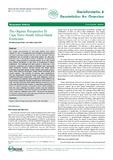Please use this identifier to cite or link to this item:
https://cris.library.msu.ac.zw//handle/11408/3520Full metadata record
| DC Field | Value | Language |
|---|---|---|
| dc.contributor.author | Shoko, Moreblessings | - |
| dc.contributor.author | Smit, Julian Lloyd | - |
| dc.date.accessioned | 2019-04-11T13:33:09Z | - |
| dc.date.available | 2019-04-11T13:33:09Z | - |
| dc.date.issued | 2018 | - |
| dc.identifier.issn | 2327-4581 | - |
| dc.identifier.uri | https://www.scitechnol.com/peer-review/the-organic-perspective-to-cape-townsouth-africa-shack-extraction-upGk.php?article_id=7694 | - |
| dc.identifier.uri | http://hdl.handle.net/11408/3520 | - |
| dc.description.abstract | The spatial reconstruction of man-made objects from urban imagery for use in management and emergency reconnaissance has been a growing research area for over two decades. Informal settlements are an example of man-made objects and they also represent one of the greatest modern challenges of developing countries. Urban governors constantly require up to date spatial and attribute information on the state of development in these settlements. The challenge with data capture in slums lies in the numerous contextual and societal complexities that characterize these unplanned environs. Several ground and image based techniques have been tested in data creation and unlike groundbased data collection techniques, image based techniques have proved superior. The evolution of sensors, data specifications and user requirements however, create a need to revisit existing spatial reconstruction approaches. This study addresses some of the contextual and approach based limitations to data collection by proposing an organically inspired perspective to shack extraction. It uses very high resolution aerial image datasets as input in a novel multi-scale framework that employs a watershed segmentation to inform on optimum locations and split complex shack candidates. Both the outer settlement boundary (macro) and the individual shack unit candidates within that boundary are identified and traced (micro scale) at a detection rate of 94%. The results are proposed for inclusion in larger scale urban planning architectures that include social and environmental parameters. | en_US |
| dc.language.iso | en | en_US |
| dc.publisher | SciTechnol | en_US |
| dc.relation.ispartofseries | Geoinformatics and Geostatistics;Vol. 6, No. 2 | - |
| dc.subject | Organic | en_US |
| dc.subject | Shack | en_US |
| dc.subject | Image-processing | en_US |
| dc.title | The organic perspective to Cape Town-South Africa shack extraction | en_US |
| dc.type | Article | en_US |
| item.fulltext | With Fulltext | - |
| item.openairecristype | http://purl.org/coar/resource_type/c_18cf | - |
| item.openairetype | Article | - |
| item.cerifentitytype | Publications | - |
| item.languageiso639-1 | en | - |
| item.grantfulltext | open | - |
| Appears in Collections: | Research Papers | |
Files in This Item:
| File | Description | Size | Format | |
|---|---|---|---|---|
| Organicperspective.pdf | Full Text | 1.44 MB | Adobe PDF |  View/Open |
Page view(s)
180
checked on Oct 16, 2025
Download(s)
92
checked on Oct 16, 2025
Google ScholarTM
Check
Items in MSUIR are protected by copyright, with all rights reserved, unless otherwise indicated.



